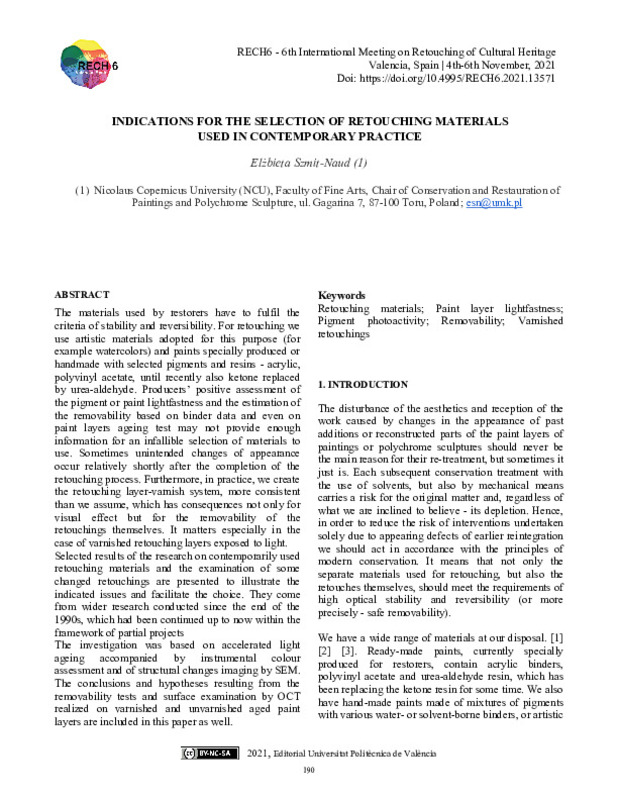JavaScript is disabled for your browser. Some features of this site may not work without it.
Buscar en RiuNet
Listar
Mi cuenta
Estadísticas
Ayuda RiuNet
Admin. UPV
Indications for the Selection of Retouching Materials Used in Contemporary Practice
Mostrar el registro sencillo del ítem
Ficheros en el ítem
| dc.contributor.author | Szmit-Naud, Elzbieta
|
es_ES |
| dc.date.accessioned | 2023-02-03T10:45:11Z | |
| dc.date.available | 2023-02-03T10:45:11Z | |
| dc.date.issued | 2023-01-11 | |
| dc.identifier.isbn | 9788413960258 | |
| dc.identifier.uri | http://hdl.handle.net/10251/191597 | |
| dc.description.abstract | [EN] The materials used by restorers have to fulfil the criteria of stability and reversibility. For retouching we use artistic materials adopted for this purpose (for example watercolors) and paints specially produced or handmade with selected pigments and resins - acrylic, polyvinyl acetate, until recently also ketone replaced by urea-aldehyde. Producers’ positive assessment of the pigment or paint lightfastness and the estimation of the removability based on binder data and even on paint layers ageing test may not provide enough information for an infallible selection of materials to use. Sometimes unintended changes of appearance occur relatively shortly after the completion of the retouching process. Furthermore, in practice, we create the retouching layer-varnish system, more consistent than we assume, which has consequences not only for visual effect but for the removability of the retouchings themselves. It matters especially in the case of varnished retouching layers exposed to light. Selected results of the research on contemporarily used retouching materials and the examination of some changed retouchings are presented to illustrate the indicated issues and facilitate the choice. They come from wider research conducted since the end of the 1990s, which had been continued up to now within the framework of partial projects The investigation was based on accelerated light ageing accompanied by instrumental colour assessment and of structural changes imaging by SEM. The conclusions and hypotheses resulting from the removability tests and surface examination by OCT realized on varnished and unvarnished aged paint layers are included in this paper as well. | es_ES |
| dc.format.extent | 15 | es_ES |
| dc.language | Inglés | es_ES |
| dc.publisher | Editorial Universitat Politècnica de València | es_ES |
| dc.relation.ispartof | 6th International Meeting on Retouching of Cultural Heritage, RECH6 | |
| dc.rights | Reconocimiento - No comercial - Compartir igual (by-nc-sa) | es_ES |
| dc.subject | Retouching materials | es_ES |
| dc.subject | Paint layer lightfastness | es_ES |
| dc.subject | Pigment photoactivity | es_ES |
| dc.subject | Removability | es_ES |
| dc.subject | Varnished retouchings | es_ES |
| dc.subject | Retouching | es_ES |
| dc.subject | Colour change | es_ES |
| dc.subject | Reversibility | es_ES |
| dc.title | Indications for the Selection of Retouching Materials Used in Contemporary Practice | es_ES |
| dc.type | Capítulo de libro | es_ES |
| dc.type | Comunicación en congreso | es_ES |
| dc.identifier.doi | 10.4995/RECH6.2021.13571 | |
| dc.rights.accessRights | Abierto | es_ES |
| dc.description.bibliographicCitation | Szmit-Naud, E. (2023). Indications for the Selection of Retouching Materials Used in Contemporary Practice. En 6th International Meeting on Retouching of Cultural Heritage, RECH6. Editorial Universitat Politècnica de València. 190-204. https://doi.org/10.4995/RECH6.2021.13571 | es_ES |
| dc.description.accrualMethod | OCS | es_ES |
| dc.relation.conferencename | RECH6 - 6th International Meeting on Retouching of Cultural Heritage | es_ES |
| dc.relation.conferencedate | Noviembre 04-05, 2021 | es_ES |
| dc.relation.conferenceplace | Valencia, España | es_ES |
| dc.relation.publisherversion | http://ocs.editorial.upv.es/index.php/RECH/RECH6/paper/view/13571 | es_ES |
| dc.description.upvformatpinicio | 190 | es_ES |
| dc.description.upvformatpfin | 204 | es_ES |
| dc.type.version | info:eu-repo/semantics/publishedVersion | es_ES |
| dc.relation.pasarela | OCS\13571 | es_ES |








